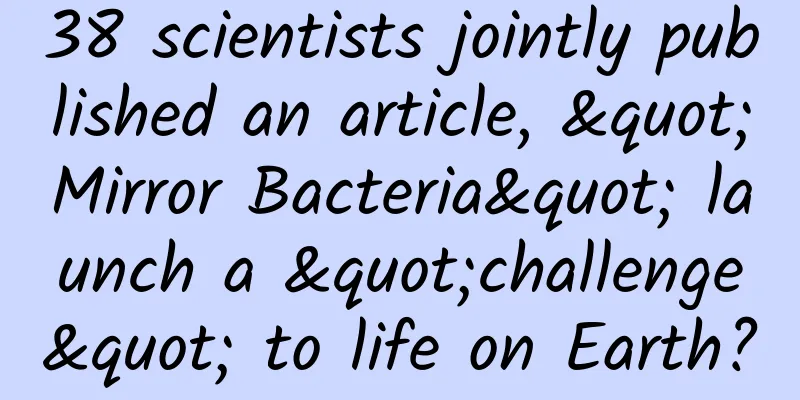38 scientists jointly published an article, "Mirror Bacteria" launch a "challenge" to life on Earth?

|
On December 11, the top international journal Science published an important article titled "Dealing with the Risks of 'Mirror Image Life'", which explored in depth the "unprecedented risks" that researching and creating "mirror life" microorganisms may pose to life on Earth. The article was co-authored by 38 top scientists from nine countries around the world, including two Nobel Prize winners and international leaders in synthetic biology, immunology, plant pathology, ecology, evolutionary biology and planetary science. The article is also accompanied by a 300-page detailed technical report that provides in-depth technical support for the analysis. Facing the risks of "mirror creatures" (Source: Document 1) With such a big situation, will this "mirror life" cause great harm? Here, let's be at ease. This article is very forward-looking. It aims to remind the industry to fully consider its risks when studying "mirror life". "Mirror life" is still far away from the lives of ordinary people, so there is no need to worry about it. So, what exactly is "mirror life" and what risks might it bring? We have to start with "mirror molecules". Mirror-image molecules in life The left and right hands of a person will reflect each other in the mirror, but they can never overlap. Some molecules closely related to life also have this characteristic, and they are divided into left-handed and right-handed according to their characteristics, which may bring completely different functions to these molecules. For example, in the pharmaceutical field, the chirality difference between left-handed and right-handed molecules can determine the efficacy and even the purpose of a drug. Levodopa is a core drug for the treatment of Parkinson's disease because it can be efficiently metabolized into dopamine by the human body, while dextrodopa is almost ineffective; dextromethorphan is a cough suppressant, but its left-handed enantiomer has analgesic effects, showing completely different physiological effects. There is also amlodipine, whose left-handed enantiomer not only has a stronger antihypertensive effect but also has fewer side effects, while the right-handed enantiomer can improve endothelial function, thereby protecting cardiovascular health. There have also been painful lessons in this regard, from a drug that was once widely used to reduce pregnancy reactions, called "thalidomide" (trade name "Thalidomide"). Of its two enantiomers, one can help pregnant women reduce pregnancy reactions, while the other can cause "seal fetuses" to be deformed. At that time, due to insufficient understanding of the effects of drugs and lack of means of detection and separation, the drug contained both enantiomers at the same time, resulting in many pregnant women taking thalidomide giving birth to deformed babies. Image from document 9 The chirality of drugs also undergoes interesting changes in different environments. Ephedrine is left-handed in aqueous solution and right-handed in ethanol solution. Although the chemical structures of left-handed and right-handed molecules are almost the same, their performance in the body may be completely different, which makes chirality an important research direction in drug development. In the field of food and nutrition, glucose is one of the most common sugars in our daily diet. It is right-handed and can be absorbed by the human body as an energy source. Its mirror image molecule, left-handed glucose, has the same chemical structure but cannot be metabolized by the human body, so it can only be added to food as a sweetener. Mirror-image glucose and alanine molecules (Source: Reference 2) Lactic acid also has chiral diversity. L-lactic acid (L-lactic acid) is an important metabolite in the human body, especially produced in muscles, helping to provide energy. However, D-lactic acid (D-lactic acid) is present in large quantities in fermented foods, such as yogurt and kimchi, and can coexist with the human body and give these foods a unique flavor. Going a step further, for some pesticides, the chirality difference is even more life-threatening... Now that we understand "mirror molecules", we can talk about what "mirror life" is. What is mirror life and where is the danger? Mirror life is a hypothetical life form whose molecular structure is a mirror image of the molecules of Earth life . The molecular chirality of mirror life is completely opposite to that of current Earth life, a property that will pose a great challenge to the immune systems of existing organisms. The immune system relies on the precise recognition and interaction between chiral molecules. For example, antigens composed of natural amino acids and sugars can be efficiently processed by the immune system. However, mirror-image proteins and nucleic acids cannot be effectively decomposed by existing immune mechanisms because the chirality of their molecular structures is completely reversed. For example, experiments have shown that mirror proteins can resist degradation by conventional enzymes and cannot produce short peptide fragments for presentation by the major histocompatibility complex (MHC), which directly leads to obstacles in antigen recognition. In addition, T cells and B cells in the adaptive immune system need to rely on antigen signals to start, but when faced with mirror molecules, they cannot recognize these signals, which in turn hinders antibody production and cellular immune responses. Image generated by AI If mirror-image microorganisms invade the human body or other organisms, they may bypass the immune defense line and spread rapidly in the host body because the immune system is almost completely unable to recognize their structure. The immune system of a healthy individual is able to eliminate invading natural chiral bacteria, but mirror-image microorganisms are able to evade a variety of defense mechanisms including innate immunity (such as the complement system) and adaptive immunity. For example, mirror-image bacteria do not activate the classical pathway or bypass pathway in the complement system, thereby avoiding dissolution or being marked for phagocytosis. In addition, many antimicrobial peptides are highly sensitive to chirality and cannot effectively interact with mirror-image microorganisms, further weakening the protective function of innate immunity. In this case, the survival and reproduction of mirror microorganisms may cause serious damage to the host. Especially when barrier tissues such as the skin, intestines and respiratory tract are damaged, mirror microorganisms may easily cross these natural barriers and enter deep tissues in the body. Once reaching these sites, mirror microorganisms will likely use nutrients in the host to rapidly proliferate. In the absence of an effective immune response to control the infection, their spread in the body may cause fatal diseases. The article in Science also stated that mirror microbes not only pose a direct threat to the health of individual hosts, but may also cause a wider spread of infection at the population level. Due to their unique immune escape ability, once spread, mirror microbes may become a major risk that is difficult to control in the field of biodefense. This phenomenon also highlights the importance of mirror life research in terms of ethics, safety and governance, and the invasion and destruction of ecosystems. Of course, considering that some nutrient molecules in our body are also chiral, just as the left hand cannot fit comfortably into the right-hand glove, mirror microorganisms may not be able to utilize these nutrients normally. From this perspective, perhaps the reproduction rate of mirror microorganisms will be reduced, but the risks mentioned above cannot be ignored. Mirror life, where has the scientific community come so far? Mirror life consists of left-handed nucleotides to form DNA and right-handed amino acids to form proteins. This form of life has not yet been found in nature on Earth, but may be achieved in the laboratory through synthetic biology technology. The first is the chemical synthesis of mirror-image biomolecules. In 2022, researchers successfully chemically synthesized a mirror-image T7 RNA polymerase of about 100 kilodaltons (kDa). This enzyme can efficiently and accurately transcribe the full-length mirror-image 5S, 16S and 23S ribosomal RNAs of up to 2,900 bases, which constitute the structure of the mirror-image ribosome, and the synthesis of the catalytic core mirror-image protein has also made a breakthrough. With mirror RNA and ribosomes, it's time to synthesize proteins. Immunogenicity is one of the main challenges in the field of protein therapy, especially long-term use of protein therapeutics can lead to the generation of anti-drug antibodies (ADAs), which reduce drug efficacy and induce adverse reactions. A promising approach to address this problem is to use mirror proteins composed of D-amino acids, which are resistant to protease degradation in immune cells. Recent studies have shown the chemical synthesis of enantiomeric forms of antibody heavy chain variable regions (d-VHH), and the potential application value of this new d-VHH screening platform in the development of protein therapeutics with low immunogenicity and higher efficacy. Since it is possible to synthesize mirror-image RNA, proteins and other life molecules, will it be far to synthesize mirror-image cells? Current synthetic biology projects are trying to build completely artificial cells from non-living matter. Scientists are trying to assemble complete synthetic cells using mirror-image molecules (such as mirror-image DNA, proteins and lipids). In addition, some studies are trying to transform natural bacteria so that they can produce mirror-image molecules in vivo as a transitional stage for the gradual transformation into mirror-image life. The core obstacles to mirror-image life are synthesizing complex molecular systems and solving high cost problems. Summarize The study of mirror life has undoubtedly opened up a new frontier of science, but it has also brought about huge ethical, safety and ecological challenges. The progress of this study from molecular basis to system construction demonstrates human enthusiasm for exploring unknown life forms, while also reminding scientists to act with caution. This exploration may bring revolutionary breakthroughs in fields such as medicine and biotechnology, but it may also lead to unforeseen risks due to technological abuse or negligence. As called for in the Science article, we should establish a sound regulatory framework while opening up research to ensure a balance between scientific progress and social security. Mirror life may be a Pandora's box, but the key to opening the box still lies in the common wisdom and rational thinking of scientists and the whole society. The good news is that mirror life will not become a threat in the short term, because the current technology is still not enough to build a complete mirror life. Since the scientific community has long been aware of the possible risks, we have time to make full preparations before the real realization of mirror life technology (which may take 10 to 30 years). References [1]Adamala, Katarzyna P., et al. "Confronting risks of mirror life." Science (2024): eads9158. [2]Xu, Yuan, and Ting F. Zhu. "Mirror-image T7 transcription of chirally inverted ribosomal and functional RNAs." Science 378.6618 (2022): 405-412. [3]Aoki, Keisuke, et al. "Engineering a low-immunogenic mirror-image VHH against vascular endothelial growth factor." ACS Chemical Biology 19.5 (2024): 1194-1205. [4]KP Adamala et al., “Technical report on mirror bacteria: Feasibility and risks” Stanford Digital Repository, (2024). [5]Harrison, Katriona, et al. "Synthesis and applications of mirror-image proteins." Nature Reviews Chemistry 7.6 (2023): 383-404. [6]Gaut, Nathaniel J., and Katarzyna P. Adamala. "Reconstituting natural cell elements in synthetic cells." Advanced Biology 5.3 (2021): 2000188. [7]Rohden, Fabian, Jörg D. Hoheisel, and Hans-Joachim Wieden. "Through the looking glass: milestones on the road towards mirroring life." Trends in Biochemical Sciences 46.11 (2021): 931-943. [8]Dintzis, Howard M., et al. "A comparison of the immunogenicity of a pair of enantiomeric proteins." Proteins: Structure, Function, and Bioinformatics 16.3 (1993): 306-308. [9] Zhang Weiguang, Zhang Shilin, Guo Dong, et al. Focus on chiral drugs: starting from the "thalidomide incident"[J]. University Chemistry, 2019, 34(9):12. DOI:CNKI:SUN:DXHX.0.2019-09-001. Planning and production Author: Denovo Popular Science Writer Review丨Hu Qiwen, Associate Professor, Department of Microbiology, School of Basic Medical Sciences, Army Medical University Planning丨Ding Zong Editor: Ding Zong Proofread by Xu Lai and Lin Lin |
Recommend
Where do “super fungi” come from and where do they go?
Reviewer: Zhang Shuyuan, Chief Physician, Beijing...
Is the birthday greeting video of an African child real? A group of African children shouting birthday wishes
A simple small blackboard with words written on i...
What are the reasons that cause Baidu to repeatedly include and delete website articles?
I believe that all responsible webmasters will en...
Information flow promotion, analysis of 7 excellent case techniques!
For third-party optimizers, advertising placement...
"Shenzhou V" "Fengyun Satellite" appeared in Lingnan? It was made of lime!
The traditional intangible cultural heritage of L...
Will artificial intelligence replace humans? Don't worry, you're overthinking it
TechCrunch, a US technology website, wrote an arti...
Perl language entry to mastery video course
Perl language entry to mastery video course resou...
Sharing of case studies on SEO operation ideas for Yizhu Decoration website!
I have just taken over the SEO of Yizhu Decoratio...
How to plan an e-commerce promotion strategy?
How to plan this kind of big promotion campaign? ...
What kind of new users is Zhihu targeting with its World Cup “brainwashing advertisement”?
During the World Cup , the brainwashing commercia...
Why did Volkswagen go against its "ancestral teachings" and accelerate the construction of Wolfsburg in Anhui as it steps on the accelerator again on the road to transformation?
Have you noticed this phenomenon? In the past era...
Metallurgical waste slag, a high-quality “coat” for highways?
Author: Li Chuanfu Shi Xiangqi As environmental a...
Affects your appearance! Habitually opening your mouth does not necessarily mean mouth breathing! What should I do if I breathe by mouth?
When you are watching short videos on your mobile...
Meizu Note 8: A 1,000 yuan price with 2,000 yuan performance, 6,000 drop tests and it is a tank phone
It has been about a year since the release of Mei...
【Smart Farmers】A little romance! Scientists develop pink cotton
Recently, the cotton molecular genetic improvemen...









